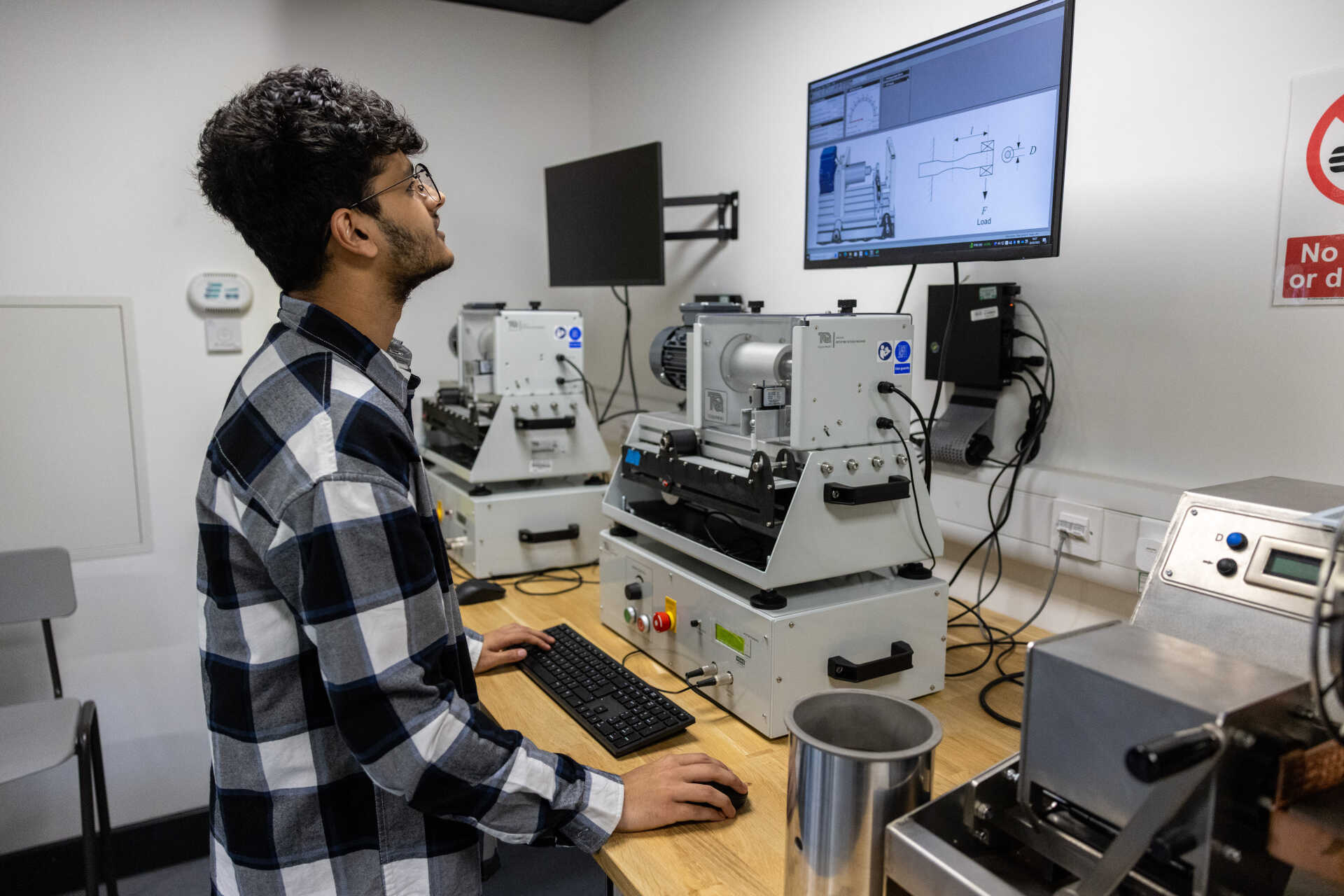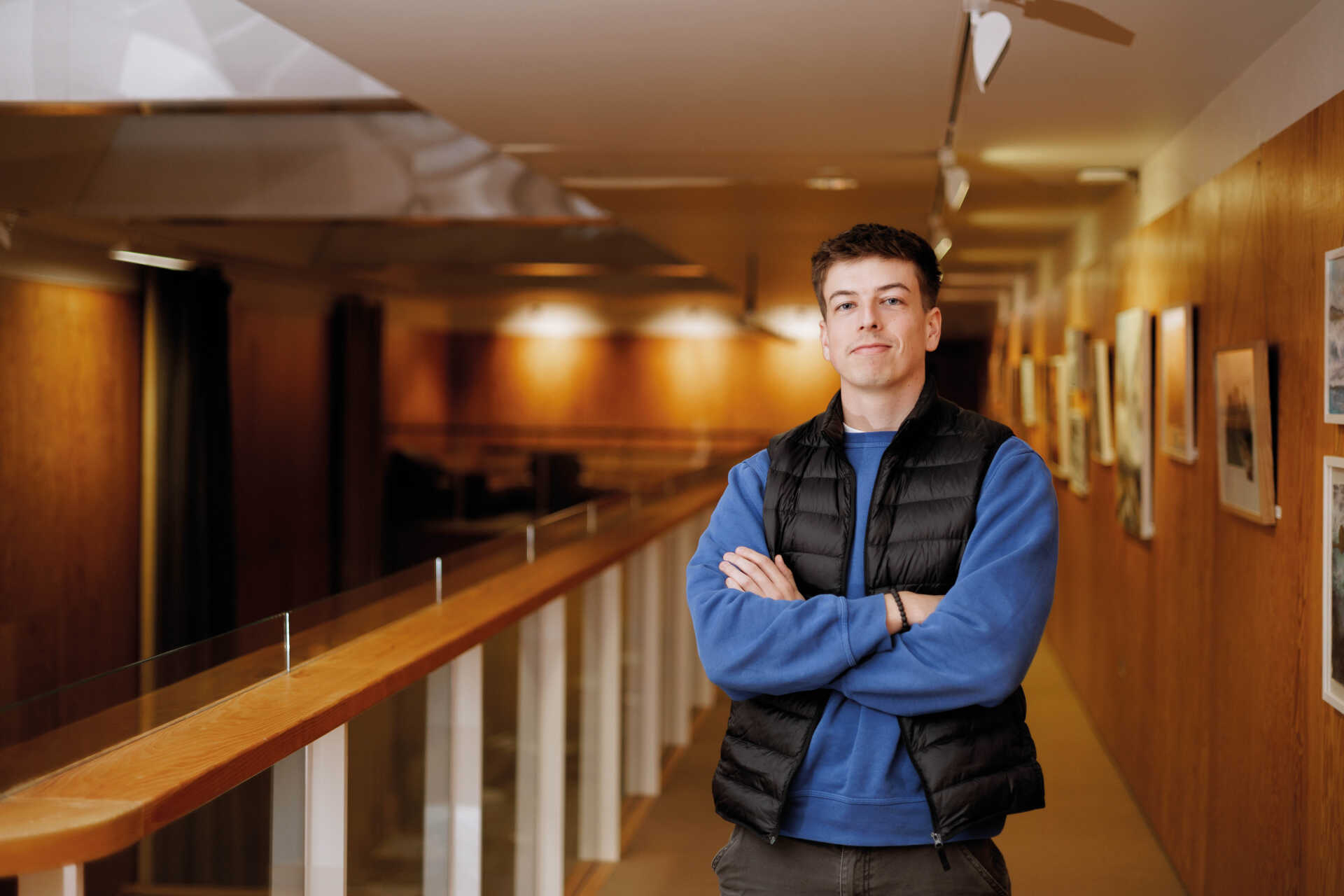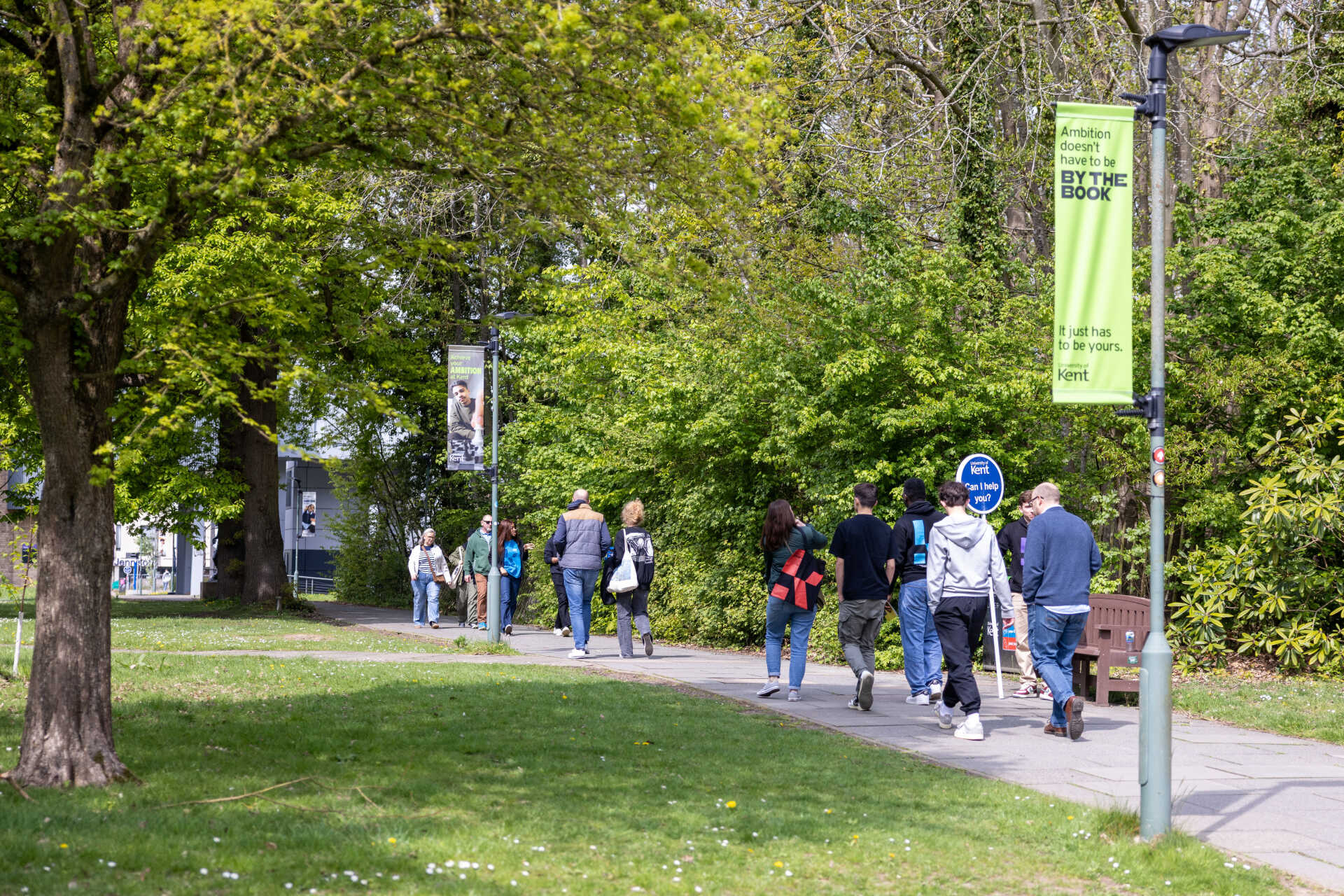Electronic and Computer Engineering
with a Year in Industry
You’ll gain the skills to innovate, create and find solutions.
Key information

You’ll gain the skills to innovate, create and find solutions.

Advancements in electronics and computing are transforming the way we live, and see the world. With this BEng in Electronic and Computer Engineering, you’ll be immersed in both - empowering you to understand, design and create the systems of the future.
This combination of electronic engineering, software, and advanced electronic hardware knowledge will give you an all-round perspective on core and emerging fields, from robotics and AI, to microcomputer technology, Internet of Things (IoT), industrial automation and sensor technologies.
At Kent, we understand that technology is always evolving. So our course prioritises hands-on, practical learning that will empower you to enter the workplace with confidence.
You will apply your knowledge to real-world systems, from autonomous vehicles to IoT devices. You’ll also work on live projects, using advanced tools and technologies as part of research or industry partnerships.
With practical, problem-solving experience, you’ll understand the factors that influence pioneering modern projects - from the importance of sustainability to the social and economic impacts of systems. You’ll also develop the teamwork and communication skills required to be part of a team that gets things done.
The additional aims of our Year in Industry option are to give students an opportunity to gain experience as computer systems engineers working in a professional environment and to develop employment-related skills. The placement year develops students’ technical skills, employability, and soft skills as well as increasing their awareness of the future context for employment.
Accredited by the Institution of Engineering and Technology on behalf of the Engineering Council for the purposes of fully meeting the academic requirements for registration as an Engineering Technician and partially meeting the academic requirement for registration as an Incorporated Engineer.
The following modules are what students typically study, but this may change year to year in response to new developments and innovations.
You’ll gain the skills that will lay the foundation for the rest of your studies – subjects include programming, engineering design and electronics.
Compulsory modules currently include the following
Mathematics is the fundamental language of engineering, allowing complex ideas to be described, formulated and developed. This module gives you a strong foundation of key mathematical techniques and methods required by most other modules in our engineering courses.
Topics covered include complex numbers, calculus, linear algebra, statistics and probability. Throughout the module, you’ll tackle real-world engineering problems. These include the study of mechanical and electrical systems, the use of complex numbers and linear algebra for the analysis of electrical circuits and the use of statistics and probability in the analysis of experimental data.
Electronics underpins all of modern life, from everyday household items to the most sophisticated supercomputers. It enables devices such as ultra-low power wearable health monitors through to megawatt wind turbines.
You’ll begin your engineering journey by learning fundamental circuit analysis and fabrication skills. This will enable you to begin engineering project work right from your first year.
You’ll also explore the vital and trusted role that engineers play in supporting and transforming society and infrastructure. You’ll do this by demonstrating your ability to consider societal issues essential to modern professional engineering.
Programming underpins all facets of modern life, from basic software applications to complex artificial intelligence systems. It enables everything from simple mobile apps to large-scale enterprise solutions.
You'll embark on your programming journey here, mastering fundamental coding concepts and development skills. This foundation will empower you to dive into programming projects right from your first year through lectures, workshops and programming challenges.
You’ll also examine the pivotal role of programmers in shaping and advancing society by exploring ethical and societal considerations essential to contemporary professional programming.
The success of an engineering product relies on the combination of careful mechanical design, strategic material selection, and a deep understanding of mechanics. These elements collectively shape the product's performance, durability, and overall effectiveness, highlighting their essential role in the development of any successful engineering solution.
You'll learn how to develop an engineering drawing of a product using a Computer-Aided Design (CAD) system and choose the best materials from a wide range of available engineering materials for your designed components.
This material selection process depends on the mechanical analysis of a component under various loading scenarios, which you will learn in this module. This knowledge will enable you to start developing an engineering project from your first year of study and practise it throughout your degree.
To bring your engineering education to life, you’ll do a project in each year of study. In the Stage 1 project, you'll gain hands-on experience, allowing you to apply theoretical knowledge to real-world problems. It will enhance your understanding of engineering principles and concepts.
Throughout this process, you’ll apply electronic and mechanical design skills and programming/software knowledge to describe and produce a physical solution alongside a technical specification. You are expected to gain a foundational understanding of engineering hardware and software integration and verification.
The module progresses through lectures, workshops, and labs, tutorials with supervision and technical guidance. It aims to provide you with hands-on and problem-solving skills in the concepts elucidated in the Term 1 and Term 2 modules.
Electronic Engineers need a knowledge of both analogue and digital electronic circuits and electronic devices to effectively design future products.
This module introduces you to analysis and design techniques and electronic component properties. You’ll learn using circuit analysis software, commonly used in industry and practical work using industrial standard measurement equipment.
Develop your understanding and techniques of the field.
Compulsory modules currently include the following
Engineers work in interdisciplinary teams to overcome the challenges of intelligent engineering systems. Smart engineering systems are not simple mechanical or electronic components, but the result of synergistic integration between mechanical engineering, electronics, computer science and control.
You’ll learn to apply this interdisciplinary approach to develop innovative solutions that would not be possible with a single-discipline focus. You’ll gain applied knowledge of sensors, actuators, and data acquisition techniques which are crucial to modern engineering. After mastering the foundational concepts, you’ll progress to cover transducers, mechanical components and modelling of mechatronic systems.
You’ll further explore microprocessors and data acquisition processes and become familiar with actuator functions within mechatronic systems. Practical sessions will complement your theoretical learning, allowing you to apply concepts in hands-on scenarios with real-world systems.
Microcomputer technology is widely used in the design and development of modern computer systems. Many of us use such applications every day, in devices such as smartphones, washing machines, microwaves and cars.
In this module, you’ll learn general principles of computer architecture and understand how the microprocessor executes instructions, interacts with hardware components and communicates with memory and I/O devices. The most common microprocessors and microcontrollers will be to compare their architectures and processing resources.
You’ll also learn a programming language that can be used on a number of microcontrollers and discover how to program and compile on a given microcontroller through a series of practical sessions. As part of a mini-project, you’ll then design and develop a microcontroller-based system using its I/O features and different communication protocols (such as RS232, SPI and I2C).
Embedded systems in conjunction with the Internet of Things (IoT) are used to create systems that can sense in real-time different aspects of their environment, collect and transmit information for a vast number of applications including smart cities, smart agriculture and smart factories (Industry 4.0). This information can then be used to transform the day-to-day operation of our cities and businesses making them more efficient and less wasteful of resources.
This module introduces the theory and practice of employing computers as the control and organisational centre of embedded systems and examines time-critical systems. You'll also cover design aspects of embedded systems and IoT through practical work, including real-time operating systems and microcomputer programming.
You will learn how to use the internal peripherals of a microcontroller by working directly at the hardware register level and as such gain a good understanding of the interactions between software and hardware. Many practical applications of embedded systems require real-time operation under strict deadlines (e.g., in factory automation). As such, the module also covers the concepts of real-time operating systems and features that are essential for time-critical operation. IoT can be used as the backbone communication infrastructure in embedded applications and the skills and knowledge you develop will be crucial in your future career.
Building on the material from Stage 1, in this module you will delve further into electronic engineering topics covering the principles and operation of essential electronic components and systems. You will learn about different passive and active electronic components (e.g., passive and active filters) focusing on both theoretical and practical aspects pertaining to the design of modern analogue and digital systems including frequency response characteristics, power-consumption and noise. You will learn about modern digital Integrated Circuit (IC) design at the circuit, chip/silicon and board level, through an introduction to the metal-oxide-semiconductor field-effect transistor (MOSFET) and Complementary MOS (CMOS) logic. You will also learn the principles of microwave technology, including the design of microwave filters and transmission lines. The module proceeds via a sequence of lectures supported by example classes, exercises and workshops designed to give practical experience of the concepts introduced in the lectures.
Signal processing as well as control systems are vital to ensure stable, safe and optimal operation of many modern devices and systems such as drones, robots and other automated platforms. This module will provide you the underpinning concepts, knowledge and methodologies in signal processing and control theory to apply to systems from your engineering disciplines. The control systems part will include both continuous and discrete time systems. The signal processing part is focused on signals, sampling filters. and will cover both analogue and digital systems. Lecture materials, hands-on experiments, computer simulations and case studies are carefully designed to strengthen your learning experience.
After successfully completing this module, you will obtain fundamental and essential knowledge in signal processing and system control required for advanced engineering learning and future professional practice in related fields.
Teamwork lies at the heart of this module, seamlessly blending practical group projects with supporting lectures, emphasising the development of technical proficiency, transferable skills, sustainability, and security awareness. You will collaborate in teams to explore mechanical and electronic hardware, software development, entrepreneurship, and sustainable practices. Through hands-on project work, you will gain expertise in sensor data acquisition, programming, hardware design, understanding security protocols, and integrating sustainability principles. Additionally, you will address crucial topics such as innovation, financial management, intellectual property protection, and commercialisation strategies with a sustainable and security-oriented perspective. By merging technical knowledge with entrepreneurial insight, sustainability principles, and a focus on security, this module equips you with a comprehensive toolkit for navigating the complexities of modern innovation and enterprise securely and sustainably.

You have the option to add a year in industry to this course. We already know you have the confidence and commitment to thrive in the workplace and kick-start your career. This is your chance to prove it, to yourself and to employers.
When should I start looking? Companies will recruit at different times of the year based on their size. It's good to be application ready by the summer of your first year.
Where can I get help finding a placement? Book an appointment with a placement adviser via the careers service.
Will I get paid? Most of our placements are paid.
Do I have to pay tuition fees? Yes, you’ll pay a substantially reduced fee. Fees for the current year (subject to changes) can be found on our tuition fees website.
Where can I get visa advice if I’m an international student? Kent Students' Union can help with any visa queries.
Does the University keep in touch? You receive four-weekly check-in emails, a visit from the team every three months and you can reach out to us any time by email or phone.
Do I work for a full year? The minimum requirement for an industrial placement is 44 weeks.
What could you do in a year?You'll further sharpen your knowledge with specialist modules. You take all compulsory modules then choose one from a list of optional modules.
Compulsory modules currently include the following
Robotics and artificial intelligence (AI) are currently the most exciting fields in engineering. We are preparing for a robotics and AI revolution that will change our lives at every level and bring us one step closer to the integration of humans and machines.
You’ll comprehensively explore the key concepts in robotics and artificial intelligence and gain essential subject knowledge. You’ll learn theoretical tools to describe kinematics and dynamics for industrial robot systems with several degrees of freedom and use cutting-edge AI and machine learning (ML) algorithms in robots. You’ll also discover software/hardware integration in robot architectures for advanced tasks (e.g. obstacle avoidance learning), industrial applications and the adoption of AI in robotics.
You’ll progress to cover industrial tests as well as statics and dynamics of robots, dynamic modelling, and industrial control strategies. By the end of the module, you’ll be equipped with a solid foundation in robotics and AI, and be empowered with essential theoretical knowledge and practical skills for designing, modelling, and controlling robotic systems.
This is an opportunity for independent study on a topic of your own choice. Working on the project is a major part of your final year of study, taking place in spring and summer terms. It’s a chance for you to conduct in-depth research on a subject that is relevant to your course, helping you to further develop essential skills.
It will also challenge you to solve problems which involve the critical consideration of engineering and relevant legal, social, ethical and professional issues. It will enable you to develop and practise a professional approach to delivering written and oral presentations. You will be allocated a supervisor who will support you through weekly meetings and other communications.
To help you build the required knowledge and skills you’ll need for a successful engineering project, you’ll attend a series of lectures and workshops. These will cover topics such as design and production techniques; reliability, availability, maintainability and safety (RAMS), quality, safety and electromagnetic compatibility (EMC); as well as ethical, environmental and EDI (equality, diversity and inclusion) issues.
Programmable logic devices are an essential element of modern digital design. Unlike a microcontroller that is software programmable (but otherwise comprises a fixed set of hardware resources), programmable logic devices such as Field-Programmable Gate Arrays (FPGAs) entail re-programming of the hardware itself. As such they allow fast prototyping and flexibility in the hardware design of modern digital systems (ranging from telecoms to control systems) due to their ability to be reprogrammed in the field.
In this module, you'll learn to program in a hardware-description language (VHDL) to model and simulate digital electronic circuits. Through a series of practical sessions, you will learn the necessary electronic design automation tools and how they are used to compile and simulate VHDL code but also “synthesise” VHDL code for placement onto actual physical hardware. You'll also learn the fundamental operational principles of programmable logic devices, FPGAs and their main processing elements, and also how modern FPGAs are used to build system-on-chips (SoCs). You will be introduced to the concepts of boundary scan testing and learn about the JTAG protocol (IEEE standard 1149.1). You'll apply knowledge gained in mini projects that will involve designing complete digital systems implemented onto FPGA, deepening your understanding and building your experience.
Communications systems and networks form the backbone of our interconnected world.
What fundamental principles can we use to efficiently exchange information? What essential techniques do we need to operate communication systems and networks in real-world scenarios?
In this module you’ll thoroughly explore communication systems and networks, examining the principles and methodologies that underpin them. You’ll develop specialist knowledge of topics such as electromagnetic wave propagation, RF circuit design, antenna principles and design, communication system models, digital modulation/demodulation techniques, network topologies, and network architecture and protocols.
You’ll also learn through extensive workshops designed to provide hands-on experience and reinforce theoretical concepts. Example classes will also boost your understanding of essential topics.
By the end of the module, you’ll have gained both knowledge and practical skills that are essential for navigating the dynamic landscape of communication systems and networks. This will give you the expertise to tackle real-world challenges and contribute meaningfully to the field of communications. You’ll also understand the context in which these systems operate, which is essential to achieving success in this rapidly evolving domain.
Optional modules may include the following
Image analysis techniques give computers the power to enhance, interpret and understand visual inputs. These techniques are integral to many applications such as autonomous vehicles, medical diagnosis, document processing, biometric security and surveillance.
You’ll learn the principles of image analysis techniques alongside their practical applications. Starting from basic image formation and acquisition, you’ll learn core image processing techniques such as how to filter noise, how to extract object outlines, how to identify regions of interest in an image (segmentation), and about image feature descriptors.
You’ll also explore various supervised and unsupervised classification techniques (including neural networks) for object recognition. You’ll discover several real-world applications of image analysis and learn through lab-based exercises and a mini-project.
In today's interconnected world, cyber security is not just important – it is essential. From businesses to schools, homes, personal devices, and even vehicles, everything is connected! This module dives deep into the fascinating realm where cyber security – including general topics and specialist areas such as cryptography – take centre stage.
Get ready to explore how these fields shape the modern technology landscape, from fundamental security principles to the intricate dance between risk management, cybercrime, usable security and professional aspects. You'll unravel the mysteries of ciphers, delve into the world of symmetric and asymmetric cryptography, and even take a critical look at cyber-attacks. You'll also examine their social and technical dimensions and explore effective risk treatment measures. This includes robust security controls and the use of upcoming mechanisms such as cyber insurance.
The knowledge you will gain on this module provides a strong foundation to guide and inform security efforts within an organisation. Prepare to embark on a journey where every click, every byte, and every line of code matters – and where you knowledge can make a real difference.
Here’s a sample timetable from your first term at Kent. You'll learn through a mix of lectures, seminars and workshops - in both big and small groups with focused teaching blocks and time to work, rest or explore uni life.
Items in green are confirmed, whereas anything marked yellow could be scheduled at a different time or day depending on your group, but this gives a good sense of what to expect.
Tuition fees in England for 2026 have not yet been set. As a guide, the 2025 annual fee for Home students is £9,535.
Tuition fees may be increased in the second and subsequent years of your course. Detailed information on possible future increases in tuition fees is contained in the Tuition Fees Increase Policy.
Fees for undergraduate students are £1,905.
Fees for undergraduate students are £1,430.
The University will assess your fee status as part of the application process. If you are uncertain about your fee status you may wish to seek advice from UKCISA before applying.
For details of when and how to pay fees and charges, please see our Student Finance Guide.
Students will require regular access to a desktop computer/laptop with an internet connection to use the University of Kent’s online resources and systems. Please see information about the minimum computer requirements for study.
There may be additional costs associated with the Year in Industry such as travel or accommodation, which will need to be covered by the student. Please see Careers and Employability webpages for more information.
Find out more about accommodation and living costs, plus general additional costs that you may pay when studying at Kent.
Kent offers generous financial support schemes to assist eligible undergraduate students during their studies. See our funding page for more details.
You may be eligible for government finance to help pay for the costs of studying. See the Government's student finance website.
Scholarships are available for excellence in academic performance, sport and music and are awarded on merit. For further information on the range of awards available and to make an application see our scholarships website.

You can use the skills and knowledge gained during this course to pursue a range of diverse roles in engineering, technology and research and development.
Previous graduates have secured roles at companies including BAE Systems, Megger, Southeastern and Rolls-Royce.
Preparing you for success
A degree can boost average lifetime earnings by over
If you are from the UK or Ireland, you must apply for this course through UCAS. If you are not from the UK or Ireland, you can apply through UCAS or directly on our website if you have never used UCAS and you do not intend to use UCAS in the future.
You can make a direct application to Kent if you pay international tuition fees, live outside the UK or Ireland and do not have or intend to have a UCAS account or application.
There is no application fee for a direct application to Kent.


